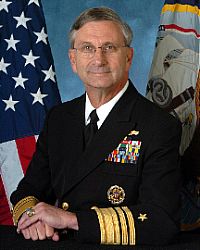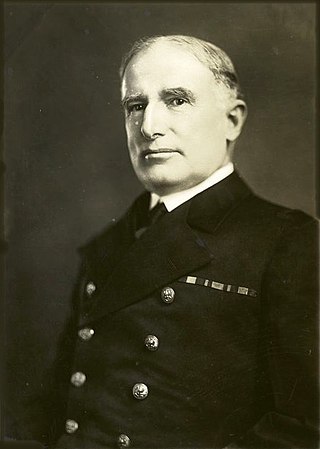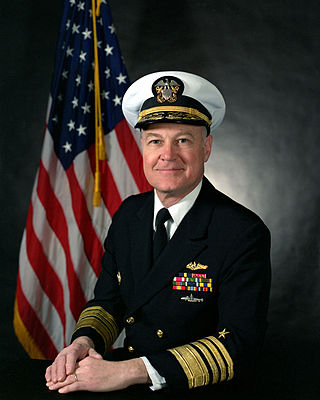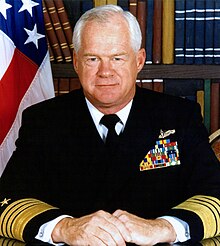
The Seventh Fleet is a numbered fleet of the United States Navy. It is headquartered at U.S. Fleet Activities Yokosuka, in Yokosuka, Kanagawa Prefecture, Japan. It is part of the United States Pacific Fleet. At present, it is the largest of the forward-deployed U.S. fleets, with 50 to 70 ships, 150 aircraft and 27,000 Sailors and Marines. Its principal responsibilities are to provide joint command in natural disaster or military operations and operational command of all U.S. naval forces in the region.

Isaac Campbell Kidd was a rear admiral in the United States Navy. He was the father of Admiral Isaac C. Kidd Jr. Kidd was killed on the bridge of USS Arizona during the Japanese attack on Pearl Harbor. The highest ranking casualty at Pearl Harbor, he became the first U.S. Navy flag officer killed in action in World War II as well as the first killed in action against any foreign enemy.

The Kidd-class destroyers were a series of four guided-missile destroyers (DDGs) based on the Spruance class. In contrast to their predecessor's focus on anti-submarine warfare, the Kidds were designed as more advanced multipurpose ships with the addition of considerably enhanced anti-aircraft capabilities. Originally ordered for the former Imperial Iranian Navy, the contracts were canceled when the 1979 Iranian Revolution began, and the ships were completed for the United States Navy. They were decommissioned in 1999 and sold to Taiwan, where they have served in the Republic of China Navy as the Kee Lung class since 2005.

USS Kidd (DDG-993) was the lead ship in her class of destroyers operated by the U.S. Navy. Derived from the Spruance-class, these vessels were designed for air defense in hot weather. The vessel was the second named after Medal of Honor recipient Rear Admiral Isaac C. Kidd, who was aboard USS Arizona during the attack on Pearl Harbor, and was the first American flag officer to die in World War II.

Vice Admiral William Douglas Crowder is a retired United States Navy admiral who served as Deputy Chief of Naval Operations for Operations, Plans and Strategy (N3/N5) in his final assignment, retiring in November 2009. Crowder was the 45th commander of the United States 7th Fleet from September 2006 to July 2008.

Kurt Walter Tidd is a retired United States Navy admiral. He last served as the Commander, United States Southern Command. Prior to that assignment, Tidd served as Assistant to the Chairman of the Joint Chiefs of Staff. He also served as the Director for Operations, Joint Staff (J-3) from 2012 to 2013, and as Commander, United States Naval Forces Southern Command and United States Fourth Fleet from August 5, 2011, to June 22, 2012. Confirmed by the Senate on December 16, 2015, Tidd received his fourth star and succeeded John F. Kelly as commander of United States Southern Command on January 14, 2016. Tidd held the title of "Old salt", which means he received his qualification for Surface Warfare before any other active-duty navy officer. He passed said title to Admiral Philip S. Davidson upon his retirement. Upon the May 30, 2018, retirement of his United States Naval Academy classmate, Admiral Harry B. Harris Jr., Tidd also gained the honorific of "Old Goat" – the longest-serving Naval Academy graduate on active duty. Harris presented Tidd with the Old Goat decanter in a ceremony on April 11, 2018.
United States ship naming conventions for the U.S. Navy were established by congressional action at least as early as 1862. Title 13, section 1531, of the U.S. Code, enacted in that year, reads, in part,
The vessels of the Navy shall be named by the Secretary of the Navy under direction of the President according to the following rule: Sailing-vessels of the first class shall be named after the States of the Union, those of the second class after the rivers, those of the third class after the principal cities and towns and those of the fourth class as the President may direct.

Mark William Balmert is retired United States Navy rear admiral. His last command was the joint Navy and Marine Corps Expeditionary Strike Group 3. He retired from the Navy in 2008 and joined Northrop Grumman as a Strategic Senior Consulting Manager.

The Commander, U.S. Fleet Forces Command (COMUSFF/COMFLTFORCOM) is the title of the United States Navy officer who serves as the commanding officer of the United States Fleet Forces Command. The U.S. Fleet Forces Command was originally established in 1905 as the U.S. Atlantic Fleet and as a two-star rear admiral's billet; the position has been held by a four-star admiral since March 10, 1915. The 45th, and current, commander of U.S. Fleet Forces Command is Admiral Daryl L. Caudle.

Harold Webster Gehman Jr. is a retired United States Navy four-star admiral who served as NATO's Supreme Allied Commander, Atlantic (SACLANT), Commander-in-Chief of the United States Joint Forces Command, one of the United States' Unified Combatant Commands, and Vice Chief of Naval Operations. He was also the Co-Chairman of the Commission that investigated the terrorist attack on the USS Cole and was Chairman of the Columbia Accident Investigation Board (CAIB) after the Space Shuttle Columbia disintegrated during reentry in 2003, killing all seven crew members.

Henry Braid Wilson, Jr. was an admiral in the United States Navy during World War I.

Henry Goodman Chiles Jr. is a retired United States Navy four star admiral who served as Commander in Chief, United States Strategic Command (USCINCSTRAT), from 1994 to 1996, the first naval officer to command all of the strategic nuclear forces of the United States.

Derwood Clayiborne Curtis is a retired vice admiral in the United States Navy who served as the Commander, Naval Surface Forces and concurrently Commander, Naval Surface Force, U.S. Pacific Fleet from March 2008 to June 2011.

Christopher Watson Grady is a United States Navy admiral who is currently serving as the 12th vice chairman of the Joint Chiefs of Staff since December 20, 2021.

Jon Christopher Kreitz is a retired United States Navy Rear Admiral and former Deputy Director of the Defense POW/MIA Accounting Agency. He is an Independent Director on the Board of Directors of the United States Equestrian Federation (USEF) and a member of the Board of Directors and the Executive Committee of the Surface Navy Association (SNA).















